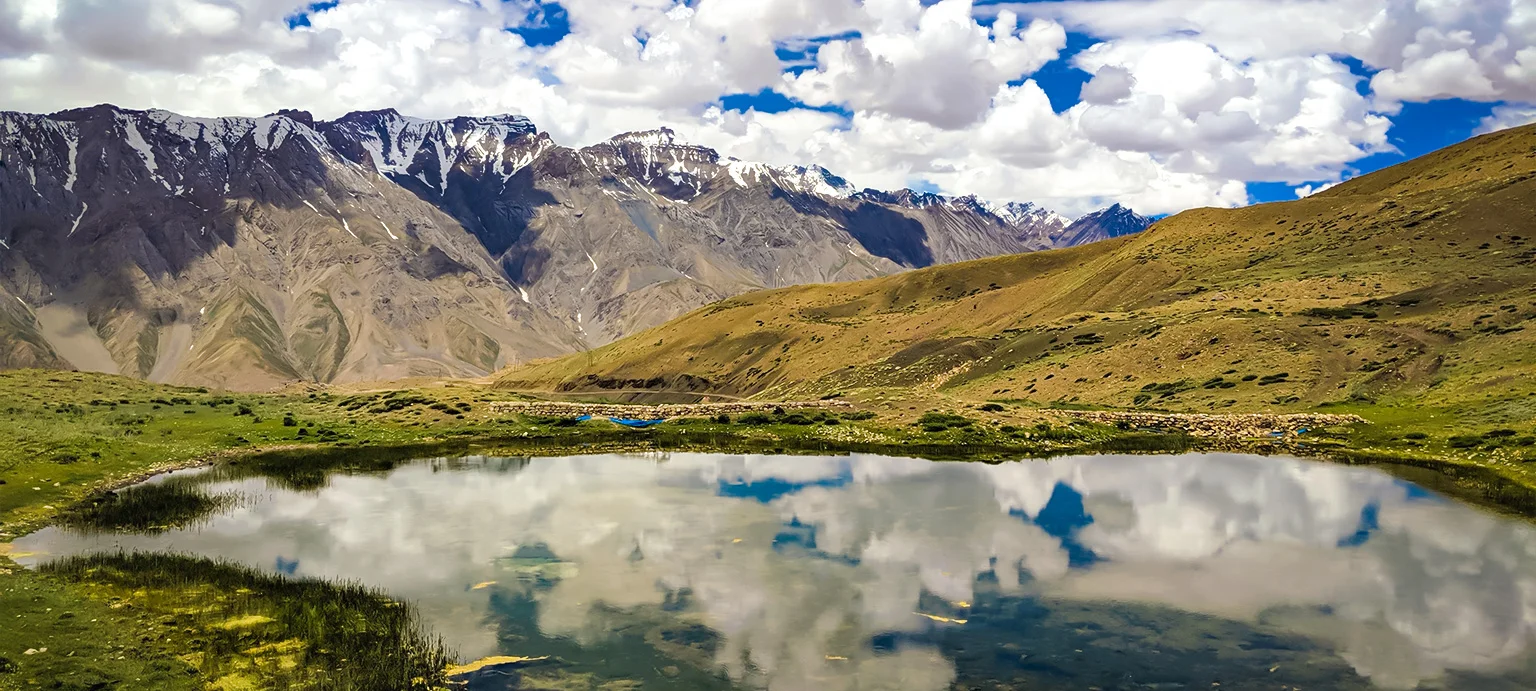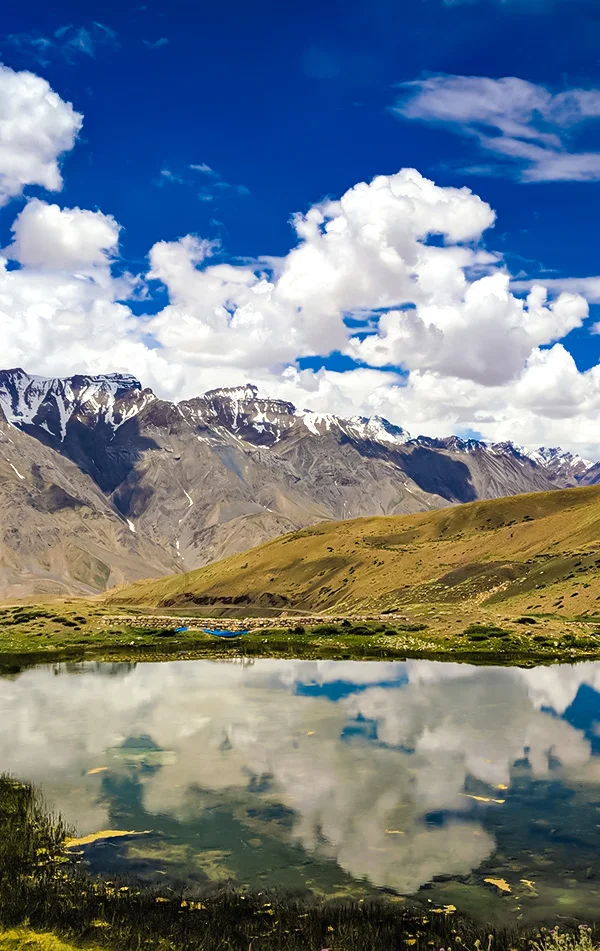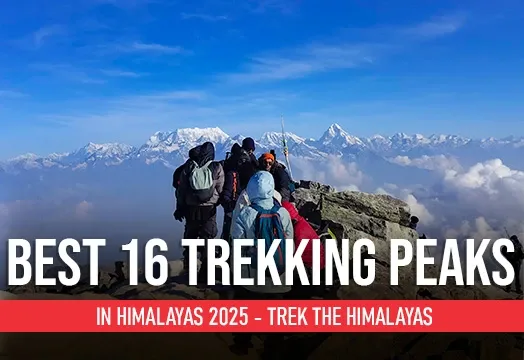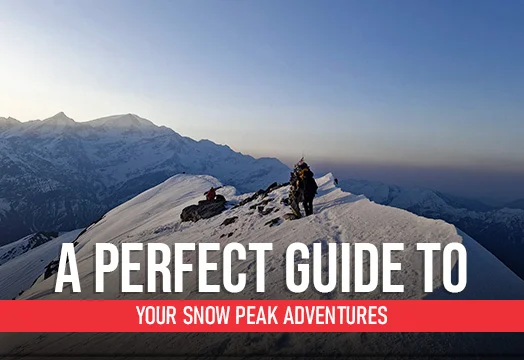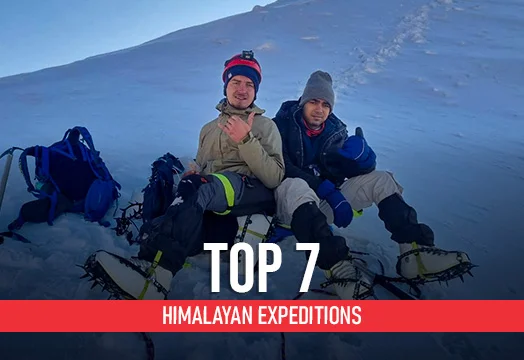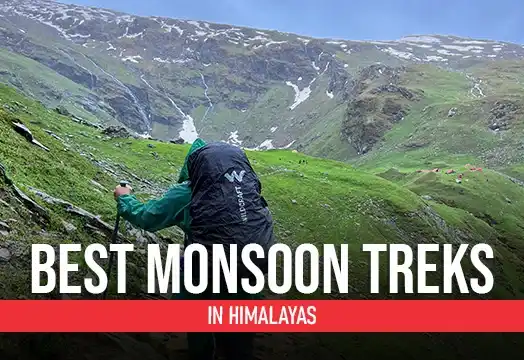Kanamo Peak Trek Expedition

Region
Himachal Pradesh | India

Duration
8 Days

Max Altitude
19553 Ft.

Trekking Km
27 KM

Grade
Challenging
Get in Touch with Our Trek Expert
91 8191004846 info@trekthehimalayas.comMonday - Saturday: 10 AM to 09.30 PM (GMT +5:30)
Sunday: 10 AM to 05.30 PM (GMT +5:30)
22500 /Person
- 5% GST will be applicable on Trek Cost and Add-ons
- Services Kaza to Kaza .
Add-ons
Transport 4000
- Transportation from Manali to Kaza and return is optional.
- Choose add-ons during booking. If missed, log in and add them later.
- Book transportation at least 10 days before the trek.
Cancellation 4 days before trek: 100% refund
Cancellation less than 4 days before trek: 50% refund
Cancellation Same-day cancellations: No refund.
- + 5% GST will be applicable
Offload 2000
- Backpack offload is optional.
- Choose add-ons during booking. If missed, log in and add them later.
- Book offload at least 10 days before the trek.
- For offline bookings at the base camp, a convenience fee of Rs. 2500 applies.
- Cancellations made before the trip date will receive a full refund.
- + 5% GST will be applicable
Get in Touch with Our Trek Expert
91 8191004846info@trekthehimalayas.com
Monday - Saturday: 10 AM to 06 PM (GMT +5:30)
Overview
Trek Name: Kanamo Peak Trek Expedition
Days: 8
Adventure Type: Trekking
Base Camp: Manali
Season:Monsoon |
Month:July | August | September |
Country: India
Altitude: 19553 Ft.
Grade: Challenging
Rail Head: Chandigarh is the nearest rail head to the base camp
Stay: Camping (Twin sharing) & Hotel/Guesthouse
Food: Meals while on trek (Veg + Egg)
Location: Himachal Pradesh
Distance: 27 Km.
Trail Type: One way trail | Camping in various locations, starting and ending at the different point.
AirPort: Bhuntar, which is 52 km away from Manali
Highlights:
- 5% GST will be applicable on Trek Cost and Add-ons
- Services Kaza to Kaza .
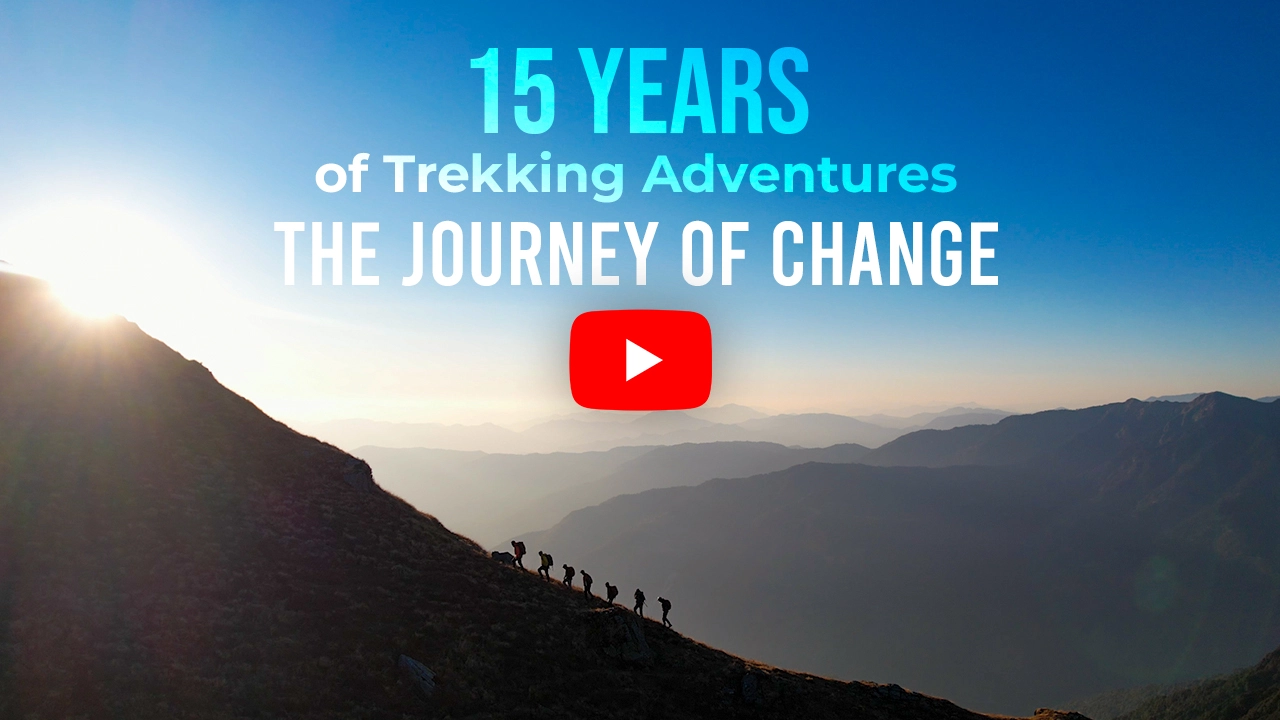
Why is Kanamo Peak a Must-Do Trek?
- The Kanamo Peak Expedition lets you experience the thrill of being at a summit of over 19500 Ft.
- From the summit you get a stunning 360 degree panoramic view of Himalayan peaks including Kinnaur, Spiti and Ladakh Ranges and even parts of Tibet.
- The trek passes through rugged landscapes of Spiti and desert mountain terrains, which are different from the usual treks.
- You get to explore the known and beautiful towns of Himachal Pradesh, including Manali and Kaza.
- You can spend time at Key Monastery, which is a prominent historical location, and visit Chicham Bridge, which is an engineering marvel.
- The journey includes a long drive through the scenic landscapes of Himachal Pradesh, which is a bucket list experience for many.
- You get to immerse yourself in the vibrant cultural beauty of Spiti, when you pass through the remote villages.
- While the trek does not require much technical climbing, you have to be prepared for the altitude changes, and that is what makes the trek challenging and thrilling.
- The clear skies of Spiti make stargazing and the Milky Way views a memorable experience.
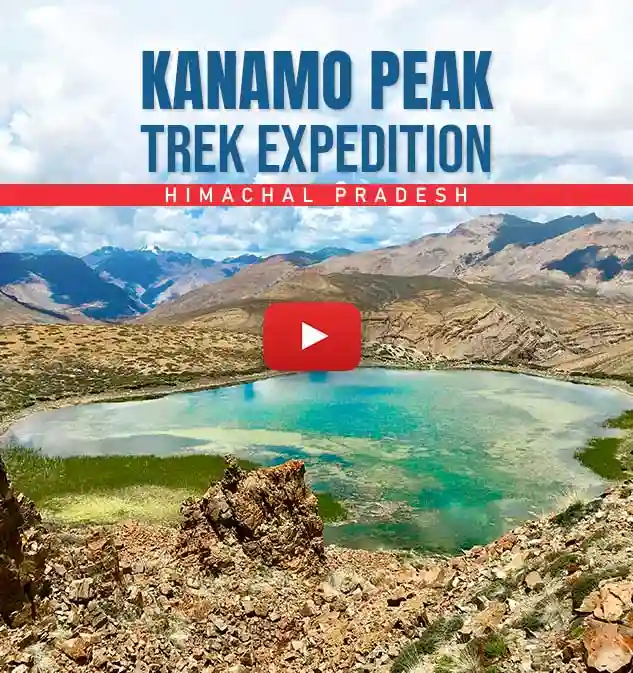
Who Can Participate
- Age Requirement:
- Minimum 18 years
- Experience of at least two high-altitude trek (4,500m- 5,000m) is required. First-timers are advised to avoid this trek.
- Fitness Criteria:
- Trekkers must be able to carry a 10-15 kg backpack, as off-load options are not recommended.
- If a trekker's BMI is more or less than the normal range (18-26), please consult our Trek Coordinator before booking.
Kanamo Peak Trek Expedition Itinerary
Arrival in Manali
This is the first day of your expedition journey, and begins with your arrival in Manali. Manali is the beautiful and well known hill station of Himachal Pradesh, and the best place to begin your adventure with.
Today, during the daytime you can explore Manali, and visit a few key destinations nearby if you want, or you can take a rest.
In the evening, the entire team will gather for a trek briefing. During this briefing session, you will meet your fellow trekkers, and get to know everything about the upcoming days. The trek briefing is led by our expert trek leaders, and you can clear all your doubts about the trek during this time. After briefing, enjoy a warm dinner with the team, then get proper rest for the following day.
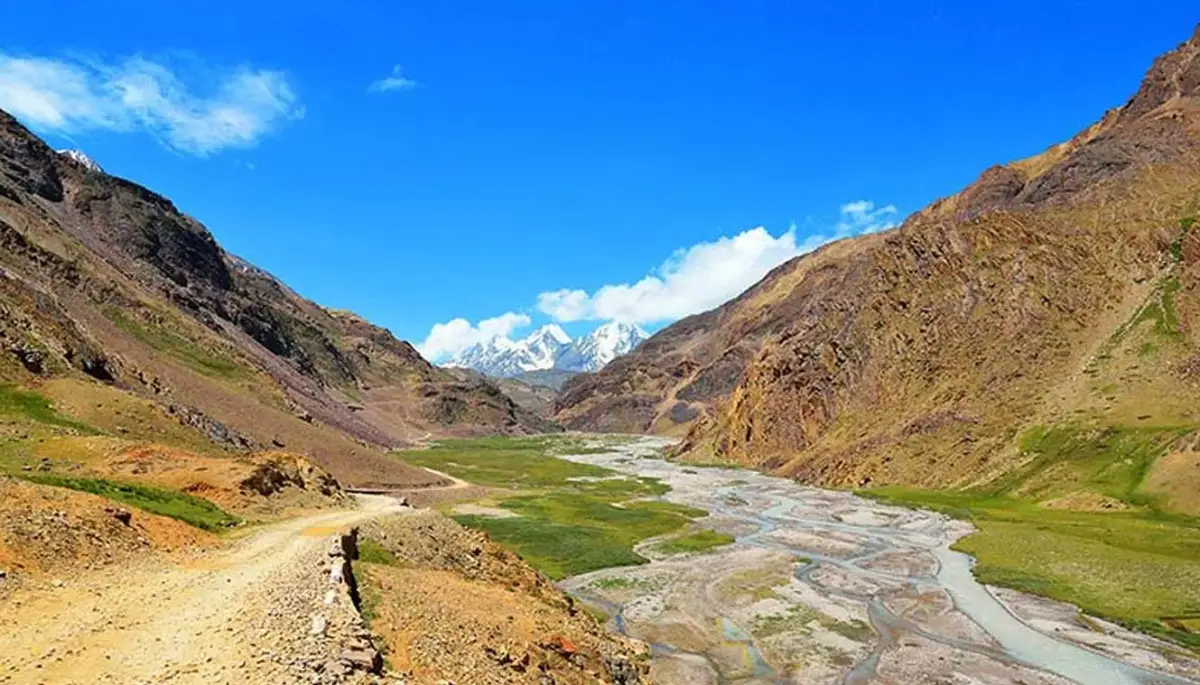
Manali to Kaza
- Altitude: 3,800m / 12,000 ft
- Early morning drive (6 am)
- 6-hour drive
- Self-paid transportation
- Stay in a guest house
- Local market and network available
You will take you by the road to Spiti from Manali. There is always a possibility of getting caught up in traffic snags on this otherwise beautiful road especially around Rohtang Pass from where a spectacular view could be found. The Manali-Leh highway offers interesting vistas of arid mountains throughout the journey but disappoints travellers with ill-maintained, rutted roads. Our advice—reach one day early in Manali and start off at dawn to enjoy the scenic route devoid of traffic. On reaching Gramphu, you would be directed towards Kaza road leading to our first stop.
Crossing Batal, you will be ushered into Spiti Valley. Picturesque villages surrounded by green patches of agricultural fields are a treat to the eyes and this view will remain with you till Kaza at the height of 11,980 feet. Here we will stop for the night at a guest house. Dinner will be served from the TTH house.
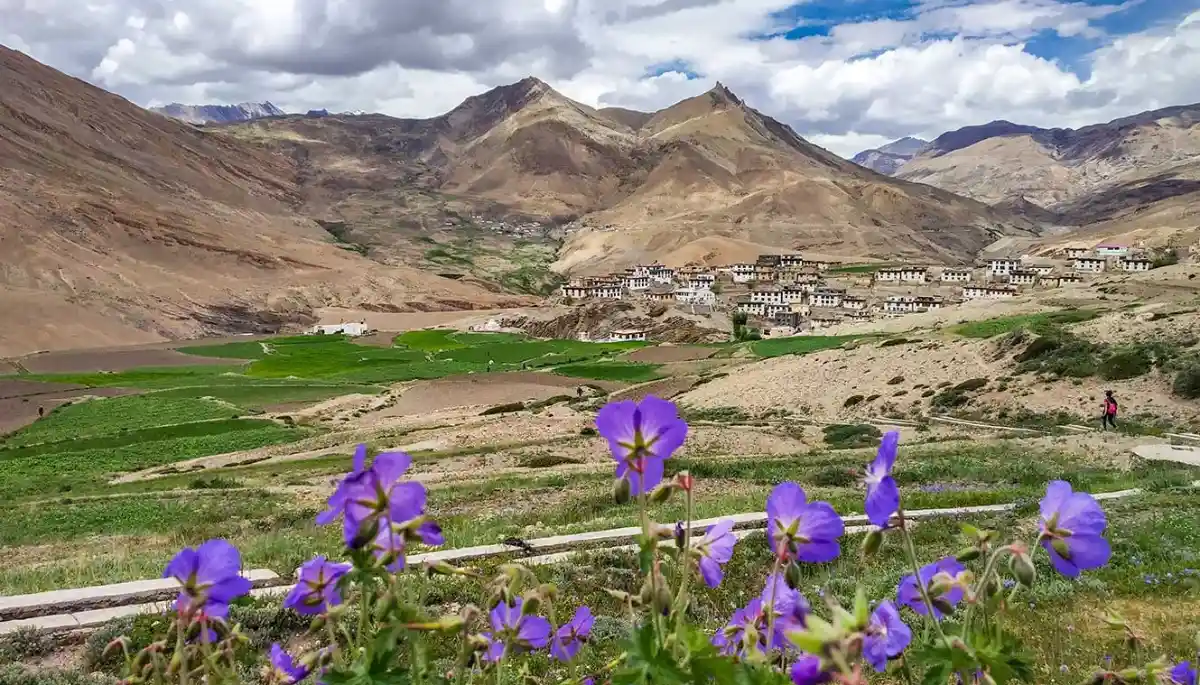
Kaza to Kibber
- Altitude: 4,100 m / 13,500 ft
- Drive: 20 km, 1 hr
- Altitude Gain: 450 m / 1,500 ft
- Visit the Key monastery
- Stay in a guest house
We will take you on an hour’s drive from Kaza to Kibber situated at an altitude of 13,500 feet. Boarding here will be provided at a guest house in the village neighborhood. Zigzagging through the cold deserts you will reach the village by lunchtime. The rest of the day could be spent exploring cultural sites in and around. The ancient Key Gompa is situated in Kaza.
The Monastery’s high reaches offer you a great view of the surrounding valley and the Spiti River flows silently many feet below.
Spend your hours in the shadowy alcoves of the monastery in the company of the monks, going over prayer verses hidden in olden artifacts and manuscripts. Giving you the first taste of the rocky terrain of the mountain desert, an acclimatization walk will be conducted in the afternoon and the evening reserved for exploring village life.
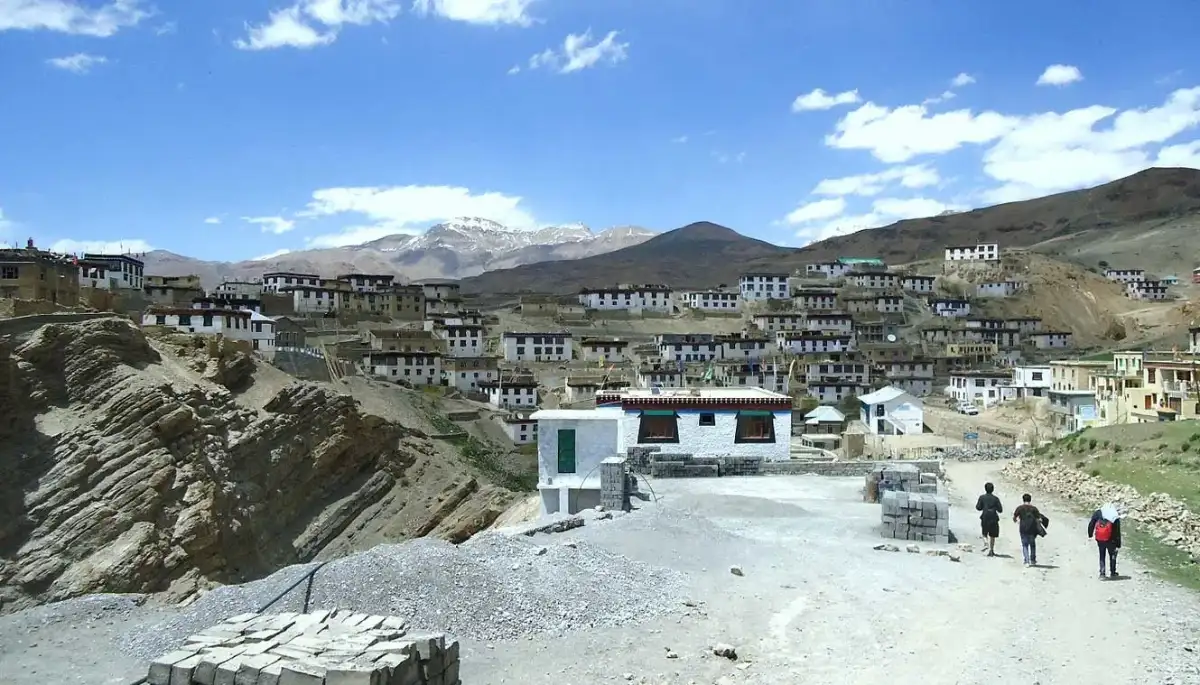
Acclimatization Day
- Stay at Kibber to acclimatize to high altitude. Light hikes around.
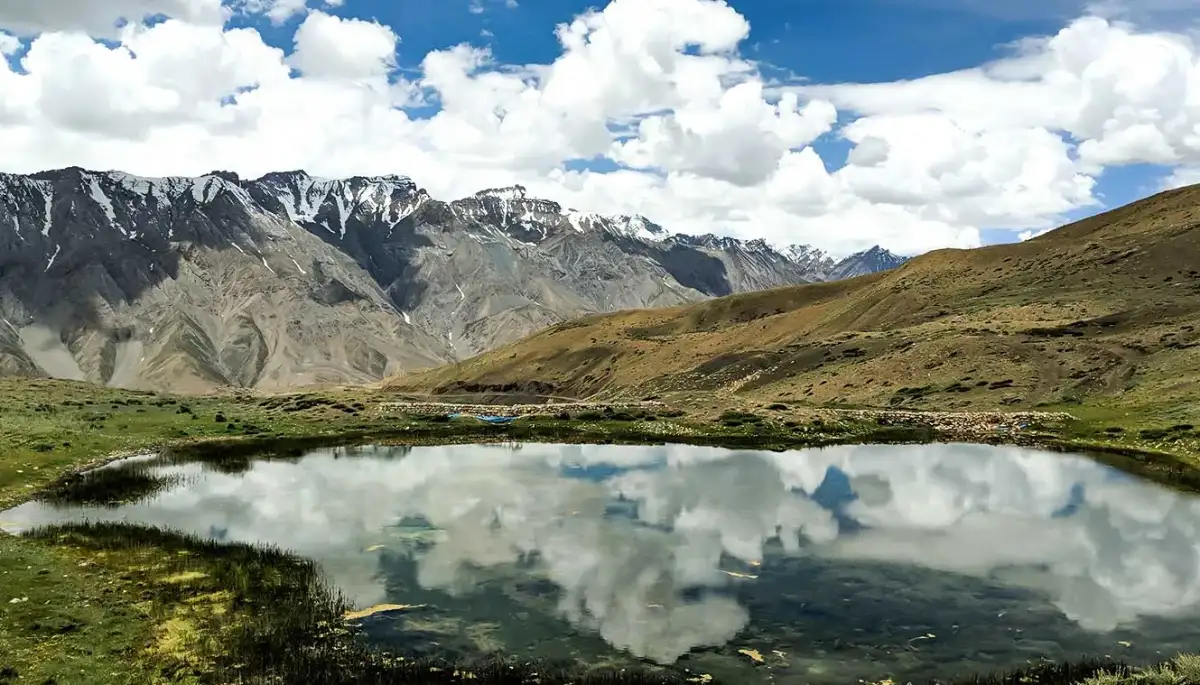
Trek to Base Camp
- Altitude: 4,700 m / 15,500 ft
- Drive Distance: 8 km | 5–6 hr
- Altitude Gain: 600 m / 2,000 ft
- Packed lunch on the way
- Accommodation in tent
- It’s a moderately difficult level climb. The ascent goes steeply for the first 4 hours, then evens out to a flat walk, followed by a short gradual ascent.
- There are no water points on the way, so carry 2 liters of water or ORS drink.
The dry grass and desert valley of Kibber offers a challenging trek on this day. Continuous ascent for the first 3 hours will be followed by a slow descent on a total 6-7 hour trek. The trail goes through a number of small villages with flourishing harvest fields and a couple of mountain lakes which are the main source of water in Kaza town. The path is filled with a variety of flowers among which the beautiful Brahma Kamal deserves a special mention.
Pay attention to your water supply on this day, making sure to carry at least 2 litres. The lakes on the passage are the only drinkable water source that you could find.
At the height of 15,748 feet in the Kanamo Peak base camp, close to the Kanamo Lake, you will be resting for the night.
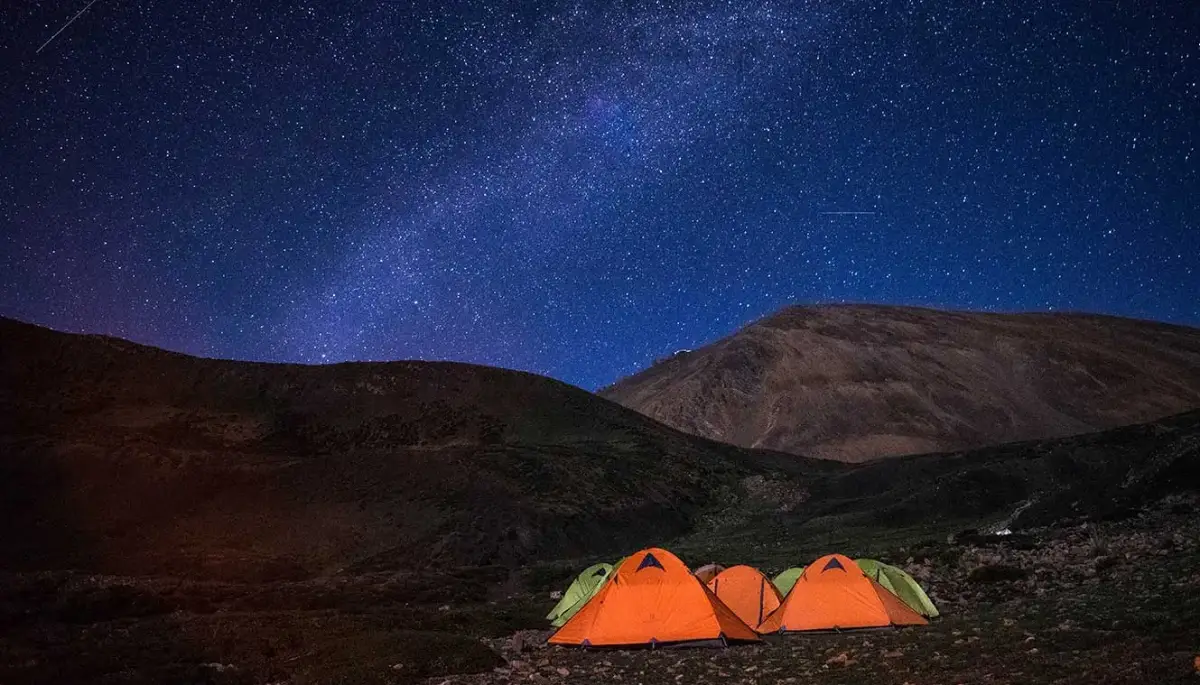
Acclimatization at Base Camp
- Rest and short acclimatization hikes to prepare for summit day.
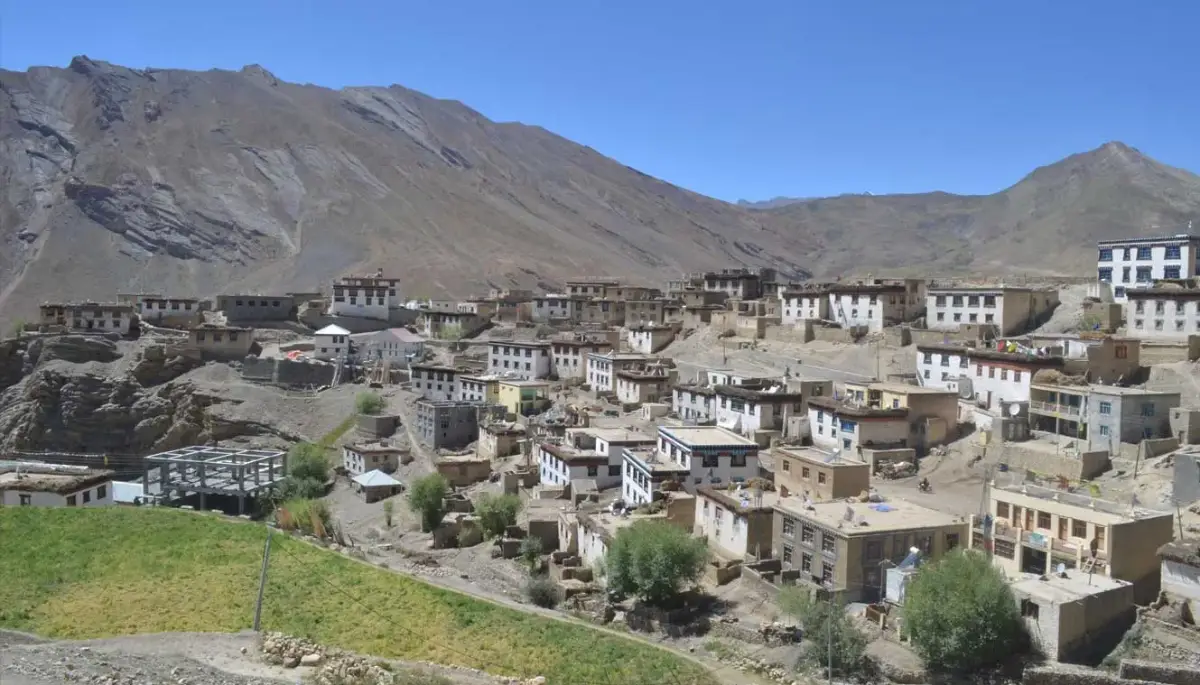
Summit Day
- Altitude: 6,000 m / 19,700 ft
- Trek: 4 km each way, 8 hrs
- Continuous ascent with 4 hours of steep climb
- Terrain: Scree-filled ground, higher up mixed with snow
- Descent time: 2.5–3 hours
- Carry 3 liters of drinking water as there are no water points on the way
Your ascent summit-ward will begin at the break of dawn as the sky slowly comes to light and the mountain ranges all around emerge from the darkness. The cold is something to be aware of in these wee hours of the morning, so, you must layer up wisely. To guard yourself against the bitter wind, wear balaclavas. Today, you will be given packed breakfast and lunch to be had stopping on the way at a favorable hour.
Loose stone chips fill up the whole trail and in the last phase snow will be found. In this scenario, stepping with a firm toehold is very important; the trick is to take large and careful steps. Avoid falling with support from your trek guide. The trek to the summit is mixed with parts of sheer ascent and a relaxing flat walk. In the ascent of 7 hour, the last 3 hour stretch will be a snow climb, be prepared for this with crampons. You will find a surface of scree and snow and as you go higher up, the snow will deepen.
Get ready for a spellbinding view of the Greater Himalayas from Kanamo top. An interesting bird’s eye view of the entire Kinnaur-Lahaul-Spiti territory will welcome you. The renowned passes—Parang La and Pin Parvati can be seen clearly at a distance. To the back of Kanamo you will find a massive glacier and snow on the nearby peaks.
The Kanamo summit is expected to remain free of extreme snow, but you must be careful to prepare adequately for the last phase of snow mixed scree.
The descent to base camp will be relatively easy and take lesser time, approximately 5 hour.
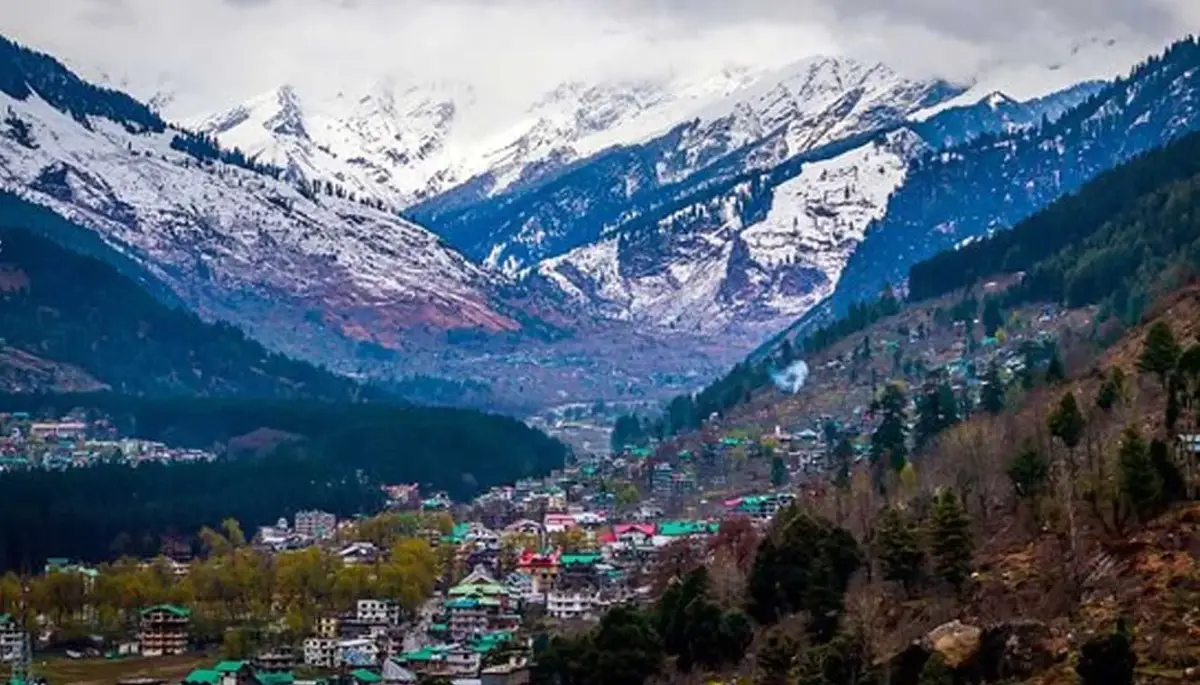
Base Camp to Kibber, drive to Kaza – Manali
- Altitude: 3,650 m / 12,000 ft
- Gradual descending trail to Kaza
- Carry sufficient water for the trek
This day, after breakfast you will be trekking your way back to Kibber, stopping for lunch here followed by a drive back to Manali through Kaza. The drive today is through the same road you came from, the path is full of scenic brilliance with a magnetic backdrop of the mountains left behind.
Day-1: Arrival in Manali
- Reach Manali and rest. Briefing and overnight stay.
Day-2: Manali to Kaza
- Altitude Kaza : 3,800m /12,000 ft.
- Drive Distance: 183km, 5hrs.
- Scenic drive through the Spiti Valley to reach Kaza (approx. 8–10 hrs). Overnight stay.
Day-3: Kaza to Kibber
- Altitude: 4,100 m / 13,500 ft
- Drive: 20 km | 1 hr
- Short drive from Kaza to Kibber village
Day-4: Acclimatization Day
- Stay at Kibber to acclimatize to high altitude. Light hikes around.
Day-5: Trek to Base Camp
- Altitude: 4,700 m / 15500 ft.
- Drive Distance: 8 km | 5-6 hrs
- Trek from Kibber to Kanamo Base Camp. Overnight camping.
Day-6: Acclimatization at Base Camp
- Rest and short acclimatization hikes to prepare for summit day.
Day-7: Summit Day
- Altitude: 19,700 ft
- Drive Distance: 8 km (both ways)| 8–9 hrs
- Early morning push to Kanamo Peak Summit (5974 m). Return to Base Camp.
Day-8: Base Camp to Kibber, drive to Kaza – Manali
- Trek Distance: 8 km | 3–4 hours
- Drive Distance: 203 km | 6 hours
- Trek back to Kibber, drive to Kaza and onward to Manali.
Note:
- Keep a buffer day in your travel plan.
- If buffer day is not used in the travel then it can be used to Explore Manali.
- Read the article Things to do in Manali.
- Distance, Altitude, and Trekking hours are approximate and rounded off.
- Keep the original and copy of ID proof handy.
- Come one day early if planning to come by flight.
Kanamo Peak Trek Expedition Graph
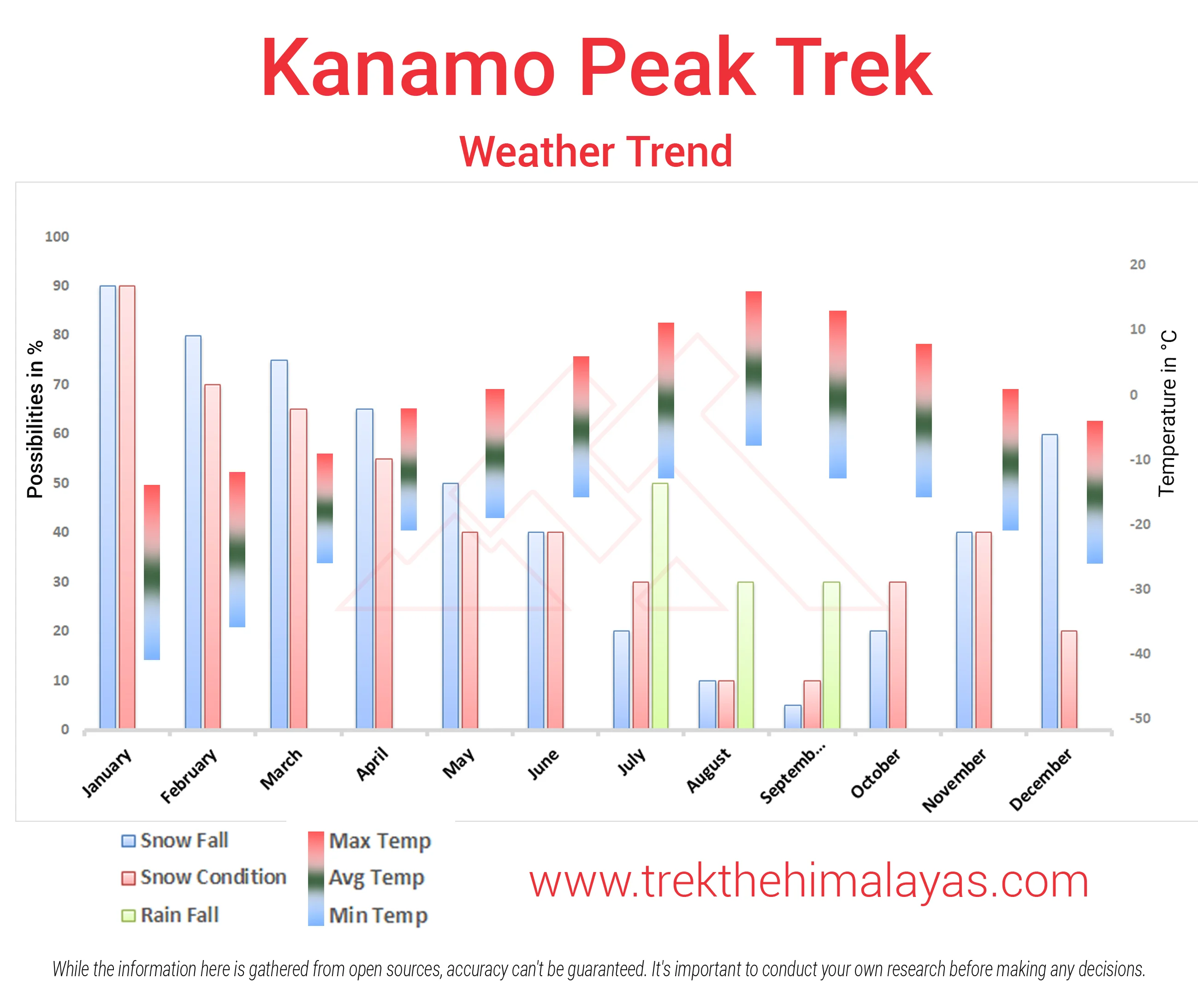
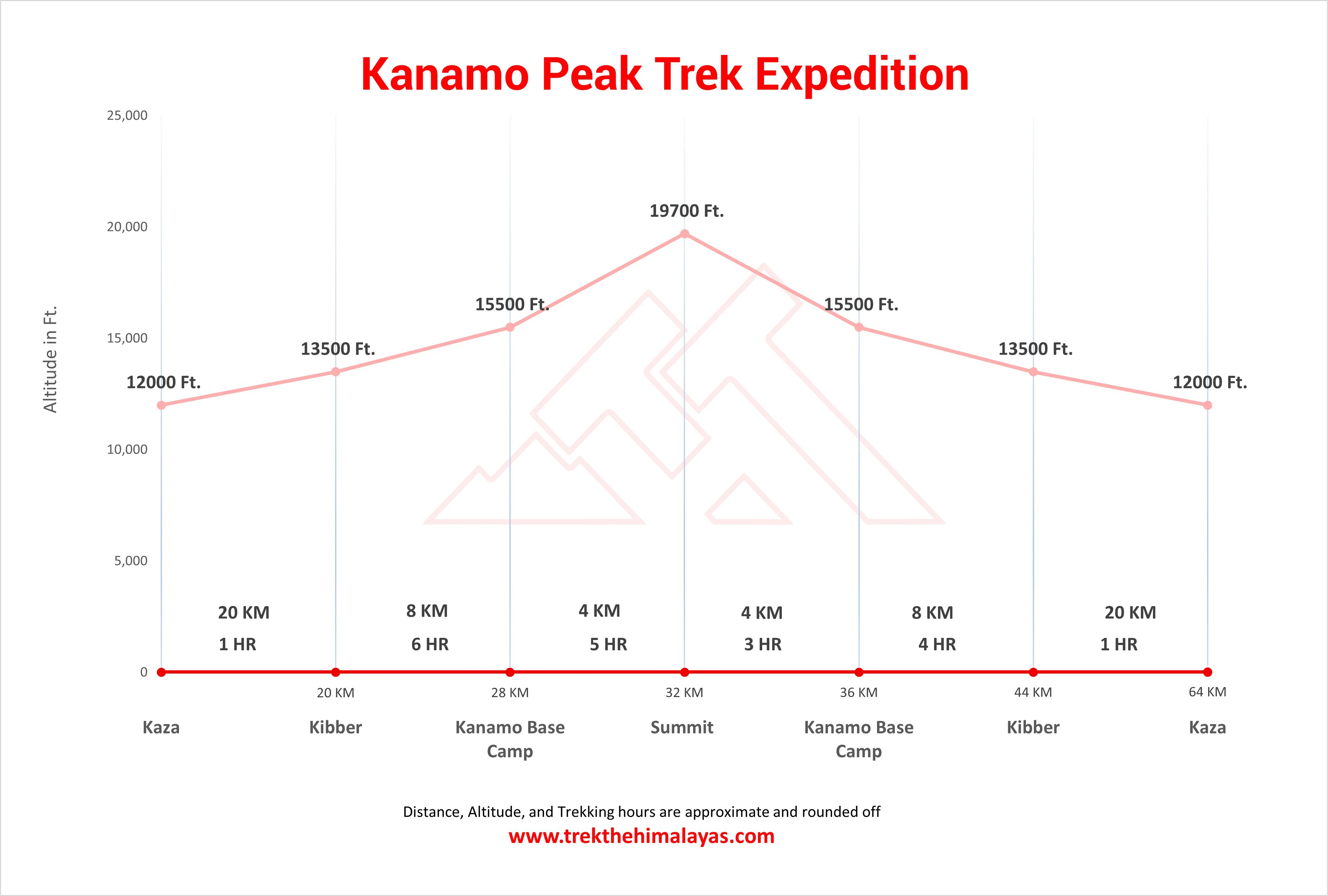
- Pulse rate at rest must be in between (60 to 100 beats per minute).
- Blood Pressure Reading must be in between (DIASTOLIC 75 – 85, SYSTOLIC 100 - 130 mm Hg).
- Respiratory rate at rest must be in between (12 to 20 breaths per minute).
- Should not have Liver and kidney issues.
- Should not have Diabetes Mellitus, Bronchial Asthma, Heart problems, Hypertension, etc.
- No pacemaker implant.
- People with Sinus issues, Epilepsy please contact to trek coordinator before booking the trek.
- If your BMI is not normal, Please contact our Trek coordinator before Trek booking.
Medical & Disclaimer Form (Mandatory Documents) Click here to download Medical & Disclaimer Form
Government employees can avail the benefit of Special Casual Leave (SCL) when they join us for a trekking expedition. As per Pay Commission guidelines, up to 30 days of Special Casual Leave can be availed in a calendar year for trekking or mountaineering expeditions conducted through a registered organisation.
Trek The Himalayas is a registered adventure tour operator with the Indian Mountaineering Foundation (IMF) and the Ministry of Tourism (MoT), making your trek eligible for SCL benefits.
To apply, email us at info@trekthehimalayas at least 20 days before the trek departure date, with the following details:
- Trek name and trek date
- Booking details
- Full name
- Designation
- Department and department address
This benefit is exclusive to Indian Government employees and is applicable only for treks within India.
- Junior trekkers (below 15 years) should have a company of parents/guardians.
- Trekkers between 15 to 18 years can come solo with the disclaimer form signed by parent/guardian.
- Medical & Disclaimer Form (Mandatory Documents) Click here to download Medical & Disclaimer Form
Important Links
- Mandatory Documents to Bring on A Trek Click Here.
- How to pay Add-ons, Submit Medical Forms, and Dietary Preferences Click Here to watch Video
How To Reach
Pick UP Information
- Once you have reached the assembly point of the trek in Manali, TTH will manage the rest of your travel arrangements, if you have opted for TTH's pick-up service, you can select this option during the booking process by adding it as an add-on.
Options to Reach Manali
First, you can arrive at Chandigarh, Delhi, Pathankot, or Bhuntar airport. The journey from these locations to Manali is explained below.
1. Take an overnight bus to Manali from Delhi or Chandigarh, taking a bus from Chandigarh is the most ideal option.
- Chandigarh to Manali Bus: 10 hours.
- Delhi to Manali Bus: 14 hours is hectic and takes more time.
( We always recommend going for the govt. Buses over the private ones outside the bus station as based on the experience we have found that there are very high chances of delay involved with private buses. Also, govt. Buses are always more reliable. Whichever bus you choose, just make sure to reach Manali at 10 am. )
2. You can take a flight to Bhuntar Airport (but we would not recommend it because of the high prices of the flight and very high chances of cancellations), Manali is just a couple of hours away and you can easily get a bus or a private taxi till there. If you do plan to come via Bhuntar, make sure to reach at least a day before the trek starts.
3. You can even come via train, Chandigarh railway station is from where you can get direct buses to Kullu/Kasol/Manali that is 275 km from there and would take an overnight journey. Even in this case, reach a day before at Manali.
( If you prefer to travel independently, you can either take a government bus or book a private cab. Your trek coordinator will provide guidance on how to arrange for the bus or cab booking.)
Drop-Off Information
- The designated drop-off point is the Manali Gov bus stand around 6:30 pm to 7:30 pm .
- Please consider planning your subsequent travel arrangements after 8:00 pm.
- It's highly advisable to keep a buffer day in your travel plan. If the buffer day is not needed, it can be used to explore Manali.
- TTH offers comfortable transportation through Tempo Traveler, Bolero, or equivalent vehicles. If you wish to upgrade your mode of transportation, please contact your trek coordinator for further assistance.
.webp)
Cost Terms
Inclusion
1. Accommodation (as per the itinerary):
- Guest house, Home stay, Camping during the trek.
- Two night accommodation in Kaza on Day 1 and Day 6 (As per itinerary) twin/triple sharing.
2. Meals (Veg + Egg):
- Meals Kaza to Kaza (Veg).
3. Support:
- 1 Versatile base camp manager: handles communication and deploys extra manpower in emergencies.
- 1 Mountaineering & First aid qualified professional trek Leader.
- 1 Experienced high altitude chef.
- Local experienced guides (Number of guides depending on the group size).
- Enough support staff.
4. Trek equipment:
- Sleeping bag, Sleeping liners (if required), Mattress, Utensils.
- 3 men all season trekker tent (twin sharing), Kitchen & Dining tent, Toilet tent.
- Camping stool, Walkie talkie.
- Ropes, Helmet, Ice axe, Harness, Gaiters & Crampon (if required).
5. First aid:
- Medical kit, Stretcher, Oxygen cylinder, Blood pressure monitor, Oximeter, Stethoscope.
6. Transportation (as per the itinerary):
- Transport Kaza to Kibber and return.
7. Mules/porters to carry the central luggage.
8. Cloakroom facility available at the base camp for additional luggage.
9. All necessary permits and entry fees, Upto the amount charged for Indian.
10. Services from Kaza to Kaza.
11. Trek Completion Certificate.
Exclusion
- Insurance (For non-Indian Nationals, NRI or OCI card holders).
- Food during the transit.
- Any kind of personal expenses.
- Mule or porter to carry personal luggage.
- Emergency evacuation, hospitalization charge, etc.
- Any extra costs incurred due to extension/change of the itinerary due to natural calamities roadblocks, vehicle breakdown, etc. factors beyond our control
- Anything not specifically mentioned under the head Inclusion.
Things can be provided on demand and availability (participant has to pay extra for these things).
1- Satellite phone/set phone - is a type of mobile phone that connects via radio links via satellites orbiting the Earth instead of terrestrial cell sites like cellphones. Therefore, they can operate in most geographic locations on the Earth's surface.
2- Gamow/PAC HAPO Bag (Portable Hyperbaric Bag) - is a unique, portable hyperbaric chamber for the treatment of acute mountain sickness (AMS), also known as altitude sickness.
3- AEDs (Automated External Defibrillators) - are portable life-saving devices designed to treat people experiencing sudden cardiac arrest, a medical condition in which the heart stops beating suddenly and unexpectedly.
Cancellation Terms
To request a cancellation, please email us at info@trekthehimalayas.com using your registered email ID.
Cancellations prior to 25 days from the start of the Trip
Refund Options
- 5% deduction of trek fee
- 100% trek fee cash voucher for any trip till one year
- Transfer your trek (any trek, any date) to your friend
Cancellation between 24 days and 15 days to the start of the Trip
Refund Options
- 30% deduction of trek fee
- 100% trek fee cash voucher for same trip till one year
- 85% trek fee cash voucher for any trip till one year
- Transfer your trek (same trek, any date) to your friend
Cancellation between 14 days and 10 days to the start of the Trip
Refund Options
- 50% deduction of trek fee
- 80% trek fee cash voucher for same trip till one year
- 70% trek fee cash voucher for any trip till one year
- Book the same trek, in the same season, with any other batch
- Transfer your trek (same trek, any date) to your friend
Cancellation less than 9 days to the start of the trek.
Refund Options
- No cash refund
- 20% trek fee cash voucher for the same trip till one year
- 10% trek fee cash voucher for any trip till one year
- Transfer your trek (same trek, same date) to your friend
- To reschedule a trek (same trek only), a 30 % rescheduling fee of the trek cost will apply.
Cancellation Policy (Emergency Cases):
In case of a death in the immediate family (parents, siblings, spouse, children) or if the trekker is hospitalized (min. 48 hours) or suffers a fracture (leg/arm) within a week before the trek, even if canceled a day before:
90% trek fee refund in cash & 10% as a voucher (valid for 1 year, for any India trek).
Valid documents required. We’re here to support you during tough times.
Note:
- Change of trek batch is dependent on the availability of seats in the batch
- In case of transferring a trek to a friend, he/she should satisfy all the mandatory requirements put forward by TTH
- TTH holds the right to change/cancel the policies, without prior notice
Booking and Payments
- The Participant is responsible for verifying the accuracy of all details, including Trip dates and personal documentation, at the time of booking.
- Payments must be made in accordance with the timelines and instructions provided by TTH. Late payments may result in cancellation of booking without refund.
- In the event of a cash refund, only the portion of the payment made in cash shall be eligible for refund in cash. Any booking made using voucher, discounts, promotional codes, or through any non-cash mode of payment shall not be eligible for a cash refund under any circumstances.
- Refunds, if applicable, shall be processed within 15–30 working days of confirmation.
- All add-on bookings are subject to the respective add-on cancellation policy, and refunds will be processed accordingly.
- Voucher Terms
- This is a non-transferable voucher
- The voucher cannot be merged with any other offer of Trek The Himalayas
- The voucher is valid for Trek booked directly with Trek The Himalayas in India
- To avail the voucher please use your register phone number or e-mail id
- All the other Terms of booking a trek with Trek The Himalayas are applicable to the voucher
Itinerary and Modifications
- TTH reserves the right to modify, shorten, or cancel any part of the Trip due to transportation delays, weather, health emergencies, or other unforeseen circumstances including Force Majeure.
Cancellations and Refunds
- No refunds or vouchers, partial or otherwise, shall be provided for voluntary withdrawal, non-utilisation of services, or removal from the Trip.
- If TTH cancels the Trip before arrival at the designated pick-up point due to unforeseen circumstances or Force Majeure, the Participant may choose from:
- An alternate Trip/date.
- A credit voucher valid for one (1) year.
- Transfer to another Trip, with cost differences payable by the Participant.
- If the Trip is abandoned post-arrival at the designated pick-up point, no cash refund or voucher shall be issued. The Trek Again Policy may apply at TTH’s discretion.
- TTH shall not be liable for any associated travel costs such as flights, accommodation, or visa fees.
Force Majeure
- Events beyond its control including but not limited to earthquakes, landslides, strikes, curfews, war, pandemic, government restrictions, heavy rainfall or snowfall, windstorms, road blockages, trail disruption, or withdrawal of permits, TTH shall not be held liable for any cancellation, delay, or service modification caused by Force Majeure.
Trek Essentials
Rent EquipmentPDF Of Trek Essential Download
| Backpack with rain cover | (50 - 60 ltr) with comfortable shoulder straps |
| Day pack with rain cover | 20 - 30 ltr (If off-load opted) |
| Walking stick | Advisable (At least one) |
| Water Bottle / Hydration pack | 2 bottles of one liter each, People who use hydration pack 1 hydration pack and 1 bottle of one liter, Carry at least one thermos flask. |
| Small size tiffin/lunch box | 1 Nos |
| Snacks | Energy bars, dry fruits, electral/ors |
| Personal Medical Kit | Consult your doctor |
| T-Shirt (Synthetic quick dry) | 1 Full & 2 Half sleeves |
| Fleece T-shirt | 1 Nos |
| Wind stopper / Fleece jacket | 1 Nos |
| Windproof Jacket | 1 Nos |
| Down feather / Hollow jacket | 1 Nos |
| Thermal inner (Upper and Lower) | 1 Pair |
| Trek Pant (Synthetic quick dry) | 2 Nos |
| Wind stopper / Fleece Pant | 1 Nos |
| Waterproof gloves | 1 Pair |
| Fleece / woollen gloves | 1 Pair |
| Poncho / waterproof Jacket and pant | 1 Nos |
| Sunscreen | 1 Nos |
| Moisturiser | 1 Nos |
| Chap-stick / Lip balm | 1 Nos |
| Toothbrush and toothpaste | 1 Nos |
| Toilet paper & Wipes | 1 Nos |
| Soap / hand sanitizers | 1 Nos |
| Antibacterial powder | 1 Nos |
| Quick dry towel | 1 Nos |
| Head torch | 1 Nos. (Avoid Hand torch) |
| Sun Cap | 1 Nos |
| Woolen cap | 1 Nos. |
| Balaclava | 1 Nos. |
| Buff / Neck-gaiters | 1 Synthetic & 1 Woollen |
| Sunglasses | UV with dark side cover, People who wear spectacles - (A)- Use contact lenses | (B)- Photo chromatic glasses |
| Trekking shoes | 1 Pair (Water-resistant, high ankle, good grip) |
| Floaters / flip-flops | 1 Pair |
| Cotton socks | 6 pairs |
| Woollen socks | 1 pairs |
| Gaiters | 1 Pair (TTH provides when required) |
| Micro spikes | 1 Pair (TTH provides when required) |
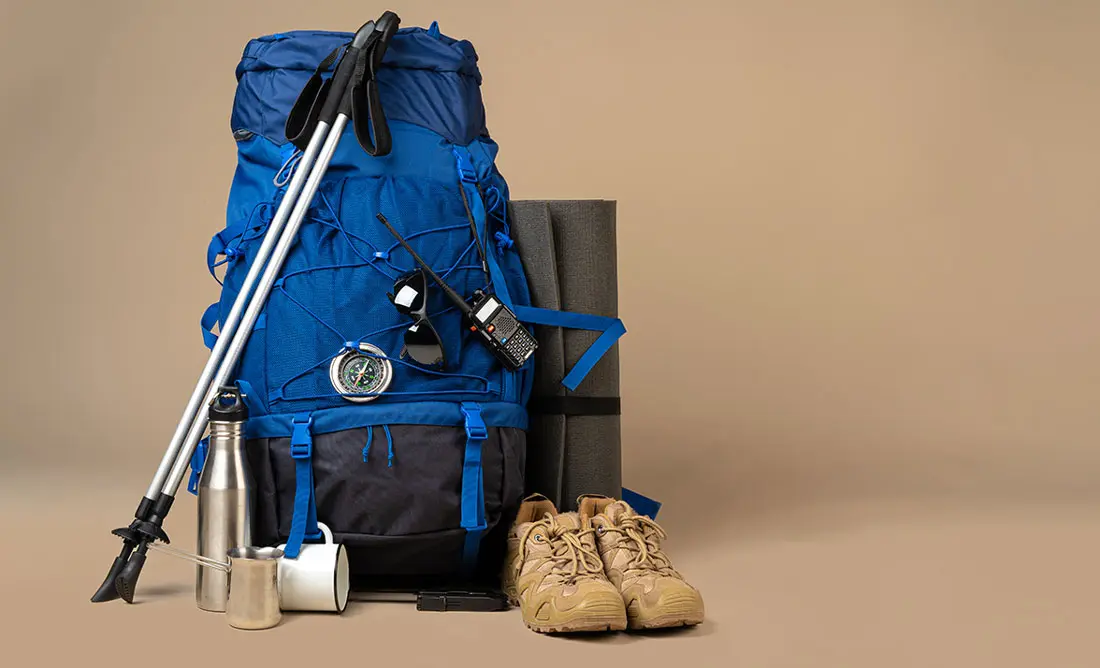
Frequently Asked Questions(FAQ)
To register with TTH, visit our website - www.trekthehimalayas.com and create your account. To create your account you will need to use your email address and fill in all the details, set your unique password and your account is ready to use.
- To book a trek with TTH, you first need to register with us and create an account.
- Choose the trek that you want to do and click on available dates.
- You will land at the login page, fill in the required details.
- Add Participants, choose add-on services click on the Pay now button, choose your preferred payment method, and make the payment. TTH accepts multiple payment options, including credit/debit cards, net banking, and UPI.
- You will receive a confirmation email from TTH with all the necessary details about the trek, including the meeting point, transportation, accommodation, and other important instructions.
- Click Here to watch Video
please send an email to us at info@trekthehimalayas.com or reach out to the numbers provided in the Help and Support section of your Trek Page. We will ensure that your issue is promptly resolved.
To book services such as off-load luggage and transportation, you can find them listed as add-ons. These additional services can be booked at the time of your initial booking. If you miss booking add-ons during the initial reservation, you can log in anytime and easily book 4 days before the departure date add-ons through the platform.
If you have booked the wrong trek or selected the wrong date, don’t worry! You can contact us at +91 9368882322 (Monday to Saturday, 10 AM to 10 PM) or email us at info@trekthehimalayas.com. You can also discuss this with your trek coordinator. Please make sure to inform us at least 10 days before the departure of your trek. Only then can we help you reschedule or arrange another trek for you.
We recommend visiting our "Suggest Me a Trek" page. By filling out the form, our experts will contact you with the best possible trek options based on your preferences and experience level. Alternatively, you can reach out to us via email at info@trekthehimalayas.com or give us a call using the numbers provided on our website for personalized assistance and recommendations.
Family treks differ from regular treks by focusing on ease of difficulty, offering shorter durations for younger participants, Kid-friendly and easily digestible foods, child-friendly activities, maintaining a higher guide ratio for diverse age groups, and implementing additional safety measures for families.
Family Trek with Kids recommendation Only Dayara Bugyal and Chopta Chandrashila Trek.
Minimum age for TTH treks is typically 7 years, though this may vary depending on the specific trek.
Yes, you can take a kids to a high-altitude trek with a parent. Discuss with a trek expert before booking a trek.
- Junior trekkers (below 15 years) should have a company of parents/guardians.
- Trekkers between 15 to 18 years can come solo with the disclaimer form signed by parent/guardian.
- Medical & Disclaimer Form (Mandatory Documents) Click here to download medical and disclaimer form
Physical Fitness: Ensure your child is physically fit. Engage them in regular exercise, outdoor activities, and hikes to build stamina and endurance. Hydration: Emphasize the importance of staying hydrated at high altitudes. Encourage your child to drink water regularly, even if they don't feel thirsty. Proper Nutrition: Provide a well-balanced diet with sufficient carbohydrates for energy and foods rich in iron to prevent altitude sickness. Adequate Sleep: Ensure your child gets enough sleep in the days leading up to the trek. Quality rest is crucial for altitude adaptation. Educate on Altitude Sickness: Teach your child about the symptoms of altitude sickness, such as headache, nausea, and dizziness. Encourage them to communicate any discomfort immediately. Appropriate Clothing and Gear: Dress your child in layers to adjust to changing temperatures. Ensure they have appropriate trekking gear, including sturdy footwear. Positive Mindset: Foster a positive mindset. Encourage your child, and let them know it's okay to take breaks when needed. Medical Check-Up: Schedule a medical check-up before the trek to ensure your child is fit for high-altitude activities. Consult with a healthcare professional about any potential health concerns.
TTH takes special care to provide wholesome and nutritious food for children on treks. Here are some of the foods that are typically served for children:
Breakfast: For breakfast, TTH serves a variety of options like porridge, cornflakes, bread, butter, jam, honey, boiled eggs, omelettes, and pancakes. Children can choose from these options to fuel themselves for the day's trek.
Lunch: For lunch, TTH serves lunch which includes rotis, vegetables, rice, dal, and salad. The rotis are usually made fresh on the trek and are a good source of carbohydrates. The dal and vegetables provide protein and other essential nutrients.
Snacks: TTH provides healthy snacks like fresh fruits, dry fruits, energy bars, cookies, and biscuits to keep the children energized throughout the day.
Dinner: For dinner, TTH serves a hot and wholesome meal which includes soup, rice, dal, vegetables, and a non-vegetarian dish (if requested in advance). Children can also choose from a variety of desserts like custard, jelly, and fruit salad.
Dietary requirements: If a child has any special dietary requirements, TTH can cater to those needs as well. For example, if a child is lactose intolerant or allergic to nuts, the kitchen staff can make arrangements to accommodate those requirements.
Choosing the right trek for a beginner can be a bit overwhelming as there are many factors to consider such as distance, elevation gain, terrain difficulty, weather, and time of year. Here are some tips that can help you choose the right trek for a beginner:
1. Determine fitness level: Assess the fitness level of the beginner to understand their physical capabilities. This will help you select a trek that is challenging but not too difficult.
2. Choose a well-traveled trail: A well-traveled trail will have more amenities such as signposts, water stations, and shelter. It is also safer as there will be other hikers on the trail.
3. Consider the length of the trek: For beginners, it is recommended to start with a shorter trek that can be completed in a day or two. This will help them get acclimatized to trekking and build their confidence.
4. Look for gradual elevation gain: Choose a trek with a gradual elevation gain rather than steep ascents. This will make the trek easier and more enjoyable.
5. Check the weather: Check the weather forecast before selecting a trek. Avoid treks during the monsoon season or winter when the trails can be slippery or dangerous.
6. Research the trail: Read about the trail to get an idea of the terrain, altitude, and difficulty level. This will help you select a trek that is suitable for the beginner.
7. Consult with an expert: If you are unsure about which trek to choose, consult our trek expert Mr. Nitin (+91 70600 59773) between 10 AM to 6 PM (Tuesday - Friday). Mr. Nitin will provide you valuable advice and guidance.
Overall, it is important to choose a trek that is enjoyable, challenging but not too difficult, and suitable for the beginner's fitness level and experience.
It is not recommended for a beginner to choose a difficult Himalayan trek. Trekking in the Himalayas can be physically and mentally challenging, especially if you are not used to the high altitude, steep slopes, and rugged terrain. Choosing a difficult trek without the proper experience, fitness level, and preparation can be dangerous and put you at risk of altitude sickness, injury, and other hazards.
If you are a beginner, it is recommended to start with an easier trek and gradually build up your skills and experience. This will help you understand the challenges of trekking in the Himalayas, and also prepare you physically and mentally for a more difficult trek in the future. It is also important to choose a trek that matches your fitness level, experience, and interest.
There is no specific age limit for a beginner trekker. However, it is important to consider your physical fitness, health condition, and personal interests before embarking on a trek. Trekking in the Himalayas can be physically and mentally demanding, and requires a certain level of physical fitness and endurance.
If you have any pre-existing medical conditions or are above a certain age, it is recommended to consult with a doctor before embarking on a trek. It is also important to listen to your body and take breaks as needed during the trek to prevent exhaustion or injury.
We recommend visiting our "Suggest Me a Trek" page. By filling out the form, our experts will contact you with the best possible trek options based on your preferences and experience level. Alternatively, you can reach out to us via email at info@trekthehimalayas.com or give us a call using the numbers provided on our website for personalized assistance and recommendations.
Yes, you can join the trek. We have fixed departure groups where you can simply book your trek and we will take care of curating a group.
Before you start the trek, it is recommended that you make all the necessary phone calls as during the trek you may or may not receive network coverage, once you come back to the Base Camp, you can reconnect with your family via phone once again. You can share your trek coordinator contact detail with your family members to get the latest updates about your trek batch.
At TTH, we provide wholesome and nutritious meals during the trek. The food is vegetarian and includes a variety of dishes such as rice, dal, vegetables, chapati, paratha, pasta, noodles, and soup. We also offer snacks such as biscuits, and salty, and dry fruits during the trek. Special dietary requirements such as vegan, gluten-free, or Jain food can also be arranged if informed in advance.
If you are allergic to some foods, you need to let us know in advance so that we can make arrangements accordingly.
TTH is a trekking company that prioritizes the safety of all its participants, including women trekkers. We have a comprehensive safety system in place, which includes a dedicated team of experienced and trained trek leaders and support staff who are equipped to handle emergency situations and provide first aid.
TTH also takes specific measures to ensure the safety and comfort of women trekkers. They have a separate tent accommodation for women trekkers, female trek leaders, and support staff. They also provide separate toilet facilities for women and encourage a safe and respectful environment for all trekkers.
Moreover, TTH has a strict policy against any kind of harassment and has a zero-tolerance policy towards such incidents. They have a designated Internal Complaints Committee (ICC) to investigate and address any complaints related to harassment or misconduct. Overall, TTH has a good reputation for safety and responsible trekking practices, and women can feel comfortable and safe while trekking with them.
In case you are the only women in the group, we provide a single sleeping arrangement. Also, during the trek, the trek leader will always remain by your side to provide optimum safety and reassurance.
You can reach out to the trek coordinator to inquire about the number of female trekkers and their respective states who have booked the trek. Please note that the trek coordinator cannot disclose personal details of any trekker. Once you've confirmed your booking, a WhatsApp Group will be created for all the trekkers in your batch. This allows you to connect with fellow trekkers before the trek begins.
While many of our treks are led by female trek leaders, however, it is not possible to know which trek leader is assigned to which group. But nonetheless, whether the trek leader is male or female you can be completely assured of your safety and security with us.
Yes, it is possible to trek with periods. However, it is important to take some extra precautions and preparations to ensure a comfortable and safe trekking experience. Here are some tips that can help you trek during your period:
1. Use menstrual hygiene products that you are comfortable with, such as tampons, pads, or menstrual cups. It is recommended to carry enough supplies for the entire duration of the trek.
2. Pack wet wipes, hand sanitizer, and plastic bags to dispose of used hygiene products.
3. Wear comfortable and breathable clothing that allows for easy movement and reduces friction. Avoid wearing tight or restrictive clothing that can cause discomfort.
4. Carry pain relief medication, such as ibuprofen or acetaminophen, in case of menstrual cramps.
5. Stay hydrated and maintain a balanced diet to support your energy levels and overall health.
6. Take breaks as needed and listen to your body. If you feel uncomfortable or experience any unusual symptoms, seek medical attention immediately. It is also recommended to consult with a doctor before going on a trek during your period, especially if you have a pre-existing medical condition or are taking medication.
By taking necessary precautions and being prepared, you can have a safe and comfortable trekking experience even during your period. We provide proper disposal facilities for sanitary pad disposal during the trek.
We offer three person tents with twin-sharing for optimum comfort. A woman trekker will share a tent with another woman trekker and if you are the only woman in the group, you will be given a single accommodation for your comfort and privacy.
Yes, we do provide gears on rent. You can book it using you TTH account directly.
Mountaineering qualified Experienced and first aid certified Trek Leader, First Aid Certify local guide, Cook, helpers and supporting staff.
People suffering from Bronchitis, Asthma, High blood pressure, Epilepsy (got faints), TB , Heart problem or on higher BMI side are strictly not allowed to go on any Himalayan trek. Apart from this if you had any medical history, please let us know.
No. Alcohol and smoking isn’t allowed while on trek. It is totally misconception that it will keep you warm. Your body need to acclimatize properly and for that eat properly and drink enough water; these things will keep you warm.
Toilet tents provide a convenient solution for answering nature's call in the great outdoors. Dry toilets, in particular, offer a highly sanitary approach. By digging a pit and utilizing mud and a shovel, you can easily cover up your waste. This method ensures cleanliness and hygiene while camping or exploring in the forest.
Remember to pack essential toiletries to complete your outdoor bathroom kit and maintain proper personal hygiene during your adventures. With these practices in place, you can enjoy nature while also respecting it.
Layer Up From Head To Toe
Eat Full Meals, never sleep empty stomach
You can keep warmee (if you’re more susceptible to cold).
Use sleeping bag in right way and don’t leave free space in sleeping bag.
For upper body
– Thermal layer
– T-shirt (full-sleeves)
– Fleece T-shirt (for extreme colds)
– Fleece layer
– Thick Jacket/Down Jacket
– Waterproof or Windproof layer (outermost layer, when it is snowing or raining)
- For Lower Body
– Thermal layer
– Hiking pants (normal) or Winter hiking pants
Based on how warm you feel you can skip any of the above layers. Your outer later should be windproof since it is windy at high altitude.
The idea behind layering is that the more insulation you have the less cold you feel, and instead of wearing a very thick jacket if you wear multiple layers, your body will be better insulated against the cold.
Yes, we provide micro spikes and gaiters, if required.
Mandatory documents: 2 xerox of ID having address (addhar card/driving license), 2 Passport size photographs, hard copy Medical form signed & sealed by doctor, disclaimer form sign by trekker and high altitude insurance.
No. We don’t but we can suggest you good hotel/Stay nearby pick up location.
Yes, trekker must carry 2 water bottles 1 litre each so they can refill it at campsite for drinking and keep themselves hydrate.
You should buy shoes which has these three features –Good grip, Ankle Support and additional water resistant layers. Generally, we advise Quechua Trek 100, MH 500 and MH 100.
No one is forced to go on. There is always enough staff to split the party according to need and regroup later at the camp. Most people have no trouble reaching the highest campsite. If some members decide not to climb the final distance they can wait for the climbers to come back down the same way or take a lateral path to the descent route.
The ideal time to do the Kanamo Peak Trek is during the monsoon season, specifically in the months of July, August and September. During these months, the summit chances are higher, with better weather and better trail conditions. The daytime weather during these months is ideal for trekking, making it a much comfortable and safer experience.
Yes, previous mountaineering experience is necessary for the Kanamo Peak Trek Expedition as it is a challenging grade trek. The trek route requires you to climb steep terrains, which is suitable for experienced trekkers.
First timers are advised to avoid this trek. Experience of at least two high altitude treks ( 4500 m– 5,000 m) is required.
The height of Kanamo Peak is around 19553 ft.
The Kanamo Peak expedition spans up to 8 days, and we recommend keeping an extra buffer day, so Kanamo peak duration in total is 9 days. These days include drive from Manali to Kibber, trekking from Kibber to the summit and return, and acclimatisation days.
The total trekking distance during the Kanamo Peak Expedition is around 27 kilometers. You pass through the rugged mountains of the Spiti Valley.
The Kananmo Peak Expedition involves significant altitude gain, with the peak being at an altitude of 19,553 feet. As a result, there is a high risk of altitude sickness for those not properly acclimatized. It is important to acclimatize properly and take necessary precautions. For your safety, the itinerary is made in such a way that you get time to properly acclimatise and prepare for the summit.
The Kanamo Peak Trek Expedition requires a high level of physical fitness as the trek involves steep ascents and descents, rocky terrain, and potential altitude sickness. It is recommended to undergo physical training and preparation before attempting the trek
The Kanamo Peak Expedition is considered to be a challenging grade trek. The trek does not require much technical gear, however the slopes are steep, and altitude gain is significant which makes the trek tough. The summit day is again a tough one, you have to trek on scree, which adds to the difficulty level of the expedition.
The Kanamo Peak trek package is thoughtfully curated to offer a safe, smooth, and enriching experience. Here's what’s included:
Accommodation throughout the trek (in guesthouses and tents) for a comfortable stay.
Nutritious meals, including breakfast, lunch, and dinner.
All local transportation.
High-quality trek equipment, including tents, sleeping bags, and mats.
A well-stocked first-aid kit and basic medical support are available in case of any emergencies.
A dedicated support team comprising:
A professional trek leader to guide the group and manage coordination.
An experienced local guide familiar with the terrain and weather.
A base camp manager to ensure logistics run smoothly.
Click here to check the Kanamo Peak Expedition price.
The Kanamo Peak Itinerary is as follows:
Day 1 – Arrival in Manali
Day 2 – Manali to Kaza drive
Day 3 – Kaza to Kibber drive
Day 4 – Acclimatization Day at Kibber
Day 5 – Trek from Kibber to Base Camp
Day 6 – Acclimatization at Base Camp
Day 7 – Base Camp to summit and back to Base Camp
Day 8 – Base Camp to Kibber, drive to Kaza – Manali
Buffer Day – Reserved for weather-related delays.
Yes, it is recommended to keep 2 extra buffer days beyond the itinerary. Since this is a monsoon trek, and roads like the Chandigarh-Manali highway are prone to landslides and delays, it’s wise to reach Manali a day early and also keep an extra day for the return journey. These buffer days will help avoid last-minute stress or missing transport connections due to unexpected delays.
During the Kanamo Peak trek, you get time to indulge yourself in the rich cultural beauty of Spiti valley. You can visit amazing monasteries in Kaza and Kibber, one of the known monasteries you visit is the Key Monastery, it is the oldest and largest monastery in the Spiti Valley.
Himachal has a wide range for trekking during monsoon, including, Hampta Pass, Pin Bhaba, Pin Parvati, and Kanamo Peak Expedition.
